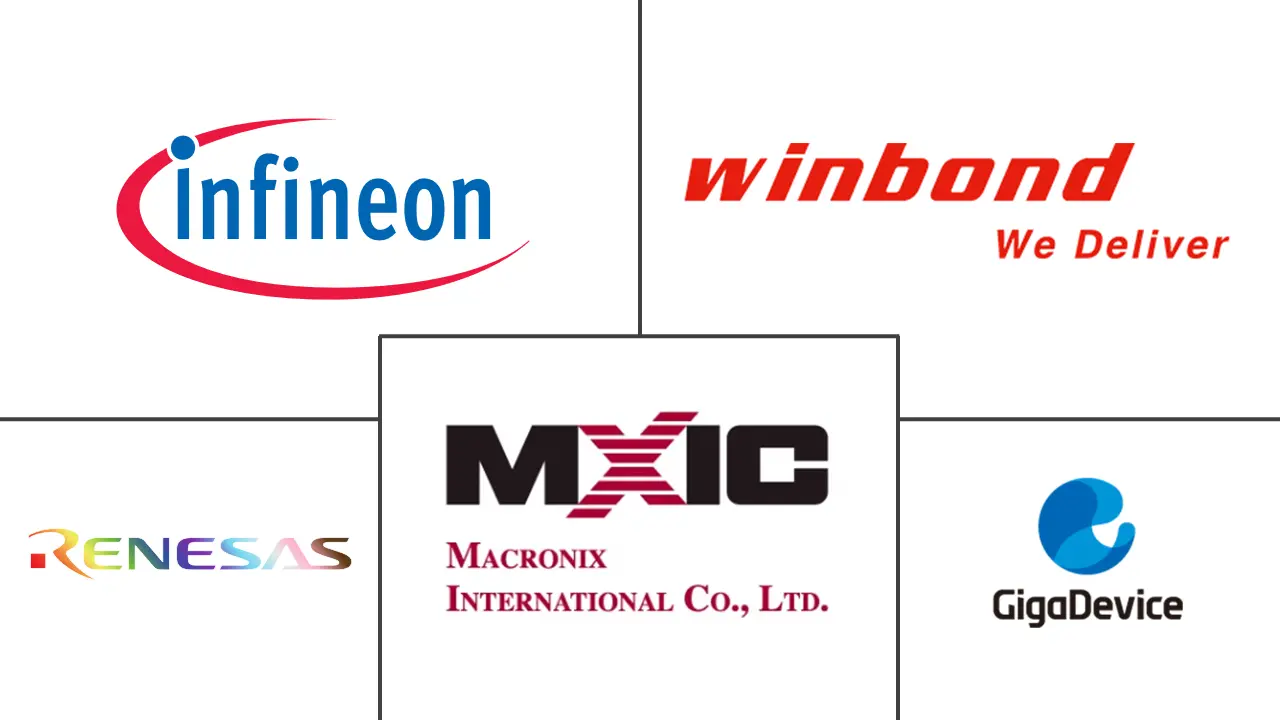Japan NOR Flash Market Size and Share
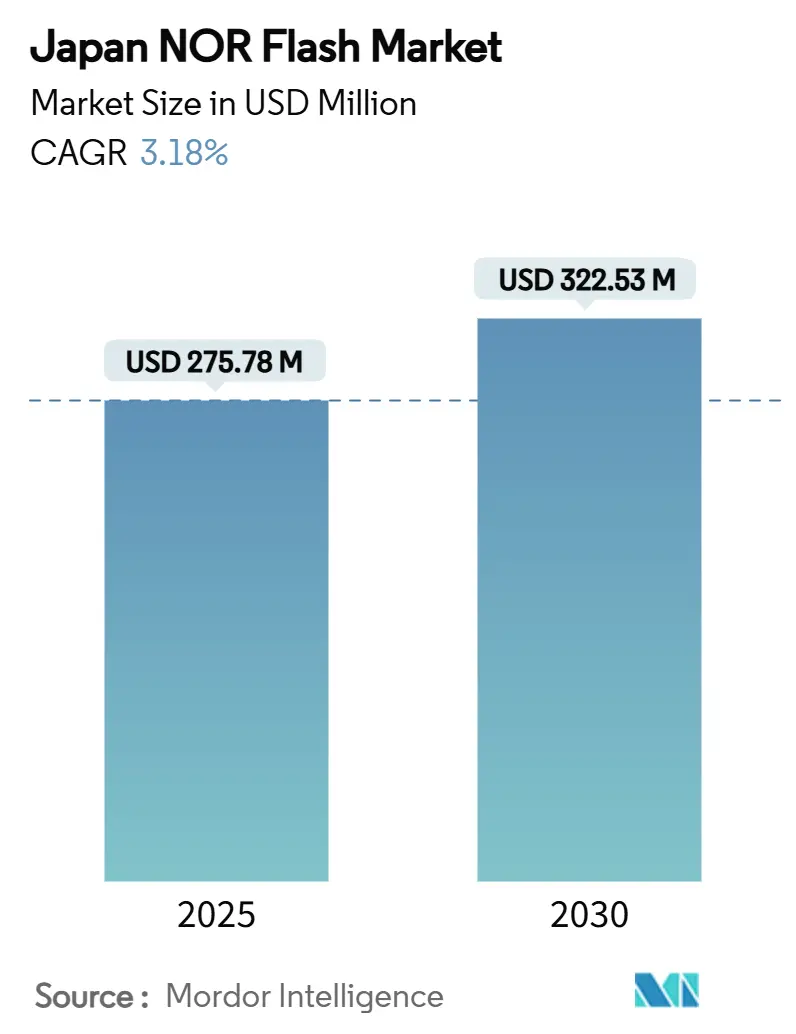
Japan NOR Flash Market Analysis by Mordor Intelligence
The Japan NOR Flash market was valued at USD 275.78 million in 2024 and is expected to reach USD 322.53 million in 2030, registering a CAGR of 3.18% during the forecast period. Japan NOR Flash market is reflecting a steady CAGR for the forecast period as the country reinforces its semiconductor value chain [1] Ministry of Economy, Trade and Industry, “Early Warning Alert Mechanism for Disruptions in the Semiconductor Supply Chain,” METI News, meti.go.jp . Growth is rooted in the technology’s fast read latency, strong endurance, and ability to execute code in place—attributes prized in automotive electronic control units (ECUs), 5G infrastructure cards, and industrial controllers. Government incentives worth JPY 3.9 trillion (USD 25.7 billion) approved between 2021 and 2023 continue to draw new wafer-fab capacity while de-risking global supply shocks [2] Taipei Representative Office, “Taiwan and the Global Semiconductor Supply Chain,” Policy Brief, roc-taiwan.org . Momentum also comes from embedded-security upgrades such as Winbond’s TrustME W77T Secure Flash, which meets ISO 26262 ASIL-D for safety-critical automotive systems [3] Winbond Electronics Corporation, “Winbond Introduces the New Automotive-Qualified W77T Secure Flash Memory,” Company Newsroom, winbond.com . Challenges remain: capital outlays to migrate below 28 nm are high, and single-level-cell (SLC) NAND competes aggressively on cost, yet domestic fab expansion plans and application-specific NOR roadmaps are offsetting these pressures. Overall, Japan's NOR Flash market continues to balance legacy demand with next-generation opportunities in vehicle autonomy, factory automation, and software-defined networks.
Key Report Takeaways
- By type, serial NOR captured 75.6% of the Japan NOR Flash market share in 2024 and is on track for a 3.5% CAGR through 2030.
- By interface, SPI single/dual led with 55.7% revenue share in 2024, while Octal and xSPI are poised for the fastest 3.3% CAGR to 2030.
- By density, the 64 Mbit tier accounted for 29.8% of the Japan NOR Flash market size in 2024; densities greater than 256 Mbit will grow at a 3.4% CAGR through 2030.
- By voltage, 3 V class devices dominated with 51.3% share in 2024, whereas 1.8 V parts are expanding at 3.3% CAGR.
- By end-user, consumer electronics held a 36.7% share in 2024, but automotive applications are advancing at the highest 3.7% CAGR to 2030.
- By process node, 55/58 nm maintained a 45.3% share in 2024, with 28 nm and below projected for a 3.6% CAGR.
- By packaging, QFN/SOIC owned 44.3% share in 2024, while WLCSP/CSP will lead growth at 3.4% CAGR.
Japan NOR Flash Market Trends and Insights
Drivers Impact Analysis
| Driver | % Impact on CAGR Forecast | Geographic Relevance | Impact Timeline |
|---|---|---|---|
| Proliferation of Embedded NOR Flash in Automotive ECUs Driven by Japan's ADAS and EV Growth | +1.20% | National, with concentration in automotive manufacturing hubs | Medium term (2-4 years) |
| Demand for High-Reliability Memory in Industrial Automation Amid Society 5.0 Initiatives | +0.80% | National, with emphasis on industrial centers | Long term (≥ 4 years) |
| Transition from LCD to OLED/MicroLED Panels Requiring Higher-Density NOR for Timing Controllers | +0.50% | National, with focus on consumer electronics manufacturing regions | Short term (≤ 2 years) |
| Expansion of 5G Base Stations and O-RAN Hardware Requiring Fast Boot-Code Storage | +0.40% | National, with urban concentration | Medium term (2-4 years) |
| Localization of Semiconductor Supply Chain under METI Resilience Programs | +0.30% | National | Long term (≥ 4 years) |
| Source: Mordor Intelligence | |||
Proliferation of Embedded NOR Flash in Automotive ECUs Driven by Japan’s ADAS and EV Growth
Automotive digitalization is lifting demand for boot memory that guarantees deterministic start-up and real-time code execution. Infineon’s SEMPER™ series achieved ASIL-D certification in May 2025, reinforcing NOR’s safety credentials in drive-by-wire architectures [4] Infineon Technologies AG, “Infineon SEMPER NOR Flash Memory Family Achieves ASIL-D Certification,” Infineon Press Center, infineon.com . As software-defined vehicles gain traction, Japanese OEMs expand ECU counts, resulting in more sockets for serial NOR. Rising semiconductor bill-of-materials per car, especially power devices and smart switches, complements this trend. Consequently, Japan NOR Flash market aligns closely with the domestic push for autonomous and electric vehicles, underpinned by subsidies for next-generation mobility.
Demand for High-Reliability Memory in Industrial Automation Amid Society 5.0 Initiatives
Society 5.0 promotes cyber-physical integration across factories, utilities, and smart infrastructure. Collaborative robots and PLCs rely on robust code storage that remains stable under vibration, temperature, and electromagnetic noise. Infineon highlights NOR Flash as a cornerstone in cobot designs requiring instant safety protocols [5]Infineon Technologies AG, “Collaborative Robots,” Infineon Application Presentation, infineon.com. . With Japan’s aging workforce accelerating automation investment, NOR Flash vendors target extended temperature grades and secure firmware features, driving incremental unit demand across industrial hubs.
Transition from LCD to OLED/MicroLED Panels Requiring Higher-Density NOR for Timing Controllers
Next-generation vehicle cockpits and premium smartphones are migrating to OLED and MicroLED displays, whose timing-controller firmware is larger and updated more frequently. Winbond reports rising NOR volumes for automotive displays as dashboard screens surpass 20 inches [6]Winbond Electronics Corporation, “Search – ADAS,” Winbond Website, winbond.com. . Higher densities (≥256 Mbit) enable advanced color calibration and on-the-fly resolution changes, sustaining a density-driven revenue mix. Given Japan’s strong display-module ecosystem, the driver positively nudges Japan NOR Flash market CAGR during the near-term ramp phase.
Expansion of 5G Base Stations and O-RAN Hardware Requiring Fast Boot-Code Storage
Telecom operators are standardizing on modular, software-controlled RAN architectures. NVIDIA’s Aerial CUDA-accelerated RAN platform, unveiled in March 2025, underscores the need for non-volatile memories that support frequent firmware loads in Massive-MIMO cards [7] NVIDIA Corporation, “Aerial CUDA-Accelerated RAN,” Technical White Paper, nvidia.com . NOR’s execute-in-place advantage minimizes RAM and speeds recovery from power interruptions, raising demand from base-station vendors integrating open-interface hardware across Japan’s urban centers.
Restraints Impact Analysis
| Restraint | % Impact on CAGR Forecast | Geographic Relevance | Impact Timeline |
|---|---|---|---|
| Capital-Intensive Migration to 28 nm and Below Nodes in Japan's High-Cost Fab Environment | -0.60% | National, with concentration in semiconductor manufacturing regions | Long term (≥ 4 years) |
| Growing Adoption of SLC NAND as a Lower-Cost Substitute in Consumer Electronics | -0.40% | National, with focus on consumer electronics sector | Medium term (2-4 years) |
| Limited Domestic Lithography Capacity Constraining High-Volume NOR Production | -0.30% | National | Medium term (2-4 years) |
| Yen Volatility Inflating Imported Photoresist and Equipment Costs | -0.20% | National | Short term (≤ 2 years) |
| Source: Mordor Intelligence | |||
Capital-Intensive Migration to 28 nm and Below Nodes in Japan's High-Cost Fab Environment
Japan’s most advanced foundries still run 40 nm, trailing global peers. Institut Montaigne estimates that JPY 5 trillion in investment is required to safeguard the national share [8] Institut Montaigne, “Racing for the New Rice – Japan's Plans for its Semiconductor Industry,” Policy Analysis, institutmontaigne.org . Equipment depreciation, EUV acquisition costs, and specialized process talent mean domestic NOR producers face margin pressure as they chase sub-28 nm competitiveness. The restraint tempers volume scaling and could delay time-to-market for higher-speed, lower-power NOR variants.
Growing Adoption of SLC NAND as a Lower-Cost Substitute in Consumer Electronics
Kioxia highlights that SLC NAND offers up to 4× cost advantage over NOR at densities above 1 Gb [9] Kioxia Corporation, “Kioxia Announces Completion of New Flash Memory Fab2 (K2),” Company Release, kioxia.com . Consumer electronics designers, sensitive to bill-of-materials, increasingly switch to NAND for code storage where random read is less critical. This substitution erodes demand for low-to-mid density NOR in mass-volume gadgets, limiting upside for Japan NOR Flash market in the price-competitive CE segment.
Segment Analysis
By Type: Serial Interface Sustains Leadership
Serial NOR accounted for 75.6% of the Japan NOR Flash market size in 2024, translating into a dominant revenue anchor across automotive clusters and smart-factory boards. Its smaller footprint and pin-efficient design allow dense PCB layouts, and ongoing speed advances, such as GigaDevice’s 400 MB/s GD25LT series, reinforce performance credentials. Over 2025-2030, serial NOR is set for a 3.5% CAGR, underlining OEM preference for single-die solutions that simplify firmware updates.
Parallel NOR remains valuable for legacy aerospace and industrial modules needing nanosecond-level random access with memory-mapped execution. However, its higher pin count raises packaging cost and board complexity, causing gradual share attrition. Japan NOR Flash market players are refreshing parallel lines chiefly for defense, medical, and ruggedized machinery, where direct execution and long-life support outweigh power-draw penalties.
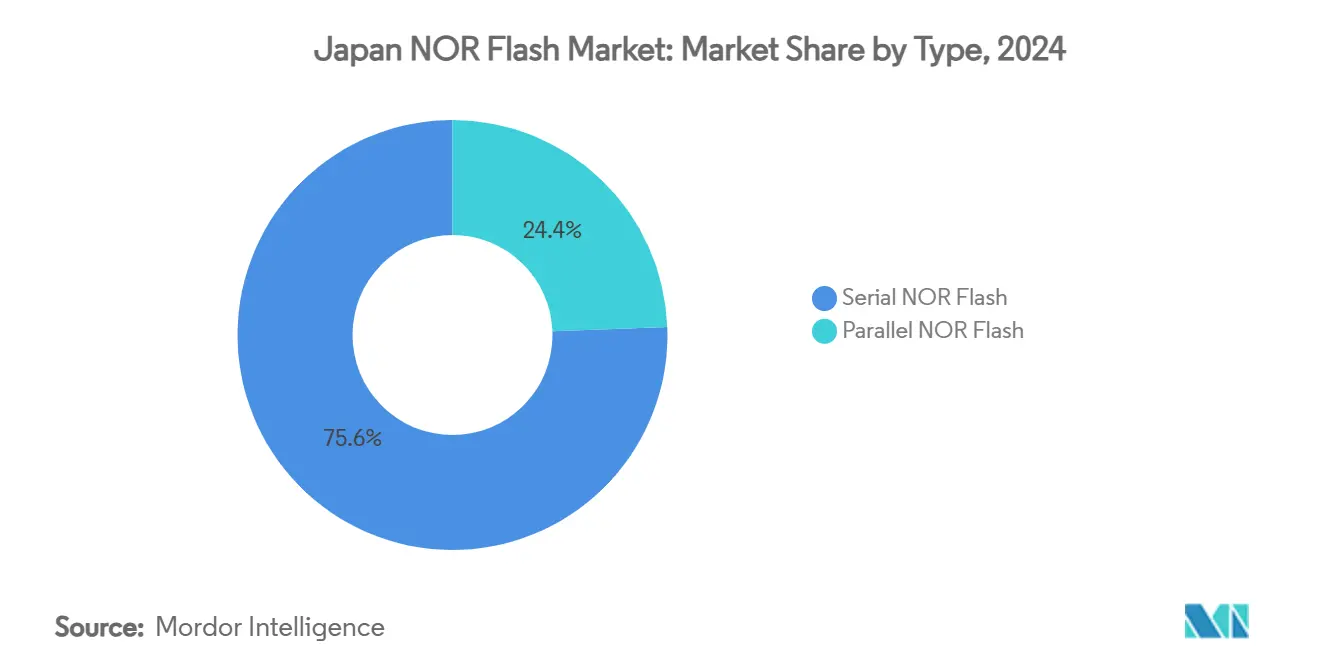
By Interface: Octal and xSPI Move Mainstream
SPI single/dual retained 55.7% 2024 share, reflecting ubiquity in low-to-mid range MCUs across consumer and industrial designs. Yet bandwidth ceilings are prompting migration to xSPI and Octal standards that triple throughput without inflating pin-count. The Japan NOR Flash market will see Octal and xSPI shipments rise at a 3.3% CAGR, spurred by real-time perception modules in ADAS that boot within milliseconds.
Quad SPI offers a transitional upgrade path, sustaining broad compatibility at moderate speed gains. Nonetheless, STMicroelectronics notes Octo-SPI’s memory-mapped mode eliminates extra copy stages, a decisive advantage for high-end infotainment systems. Vendors, therefore, allocate R&D to auto-grade octal parts with low-power-deep-sleep modes, ensuring future-proofing as 5G and V2X connectivity extend data-load sizes.
By Density: Higher Capacities Unlock New Software Loads
The 64 Mbit bracket commanded 29.8% of the Japan NOR Flash market share in 2024, marking a practical ceiling for many MCU-driven appliances. Carmakers, telecommunication OEMs, and industrial-control designers now embed more analytics, cybersecurity stacks, and over-the-air update images. Consequently, densities greater than 256 Mbit will enjoy a rapid 3.4% CAGR through 2030 as complex ECUs consolidate multiple code bases.
Mid-range densities from 16 Mbit to 128 Mbit continue to anchor mainstream revenue, balancing die cost and firmware headroom. Densities less than 8 Mbit shrink steadily because even simple sensor nodes now need encryption keys, bootloaders, and diagnostics. Higher-density serial NOR, as showcased by Infineon’s radiation-hardened 512 Mbit QSPI device, satisfies both capacity and reliability criteria for space-grade or mission-critical Japanese programs, underscoring density as a key differentiator.
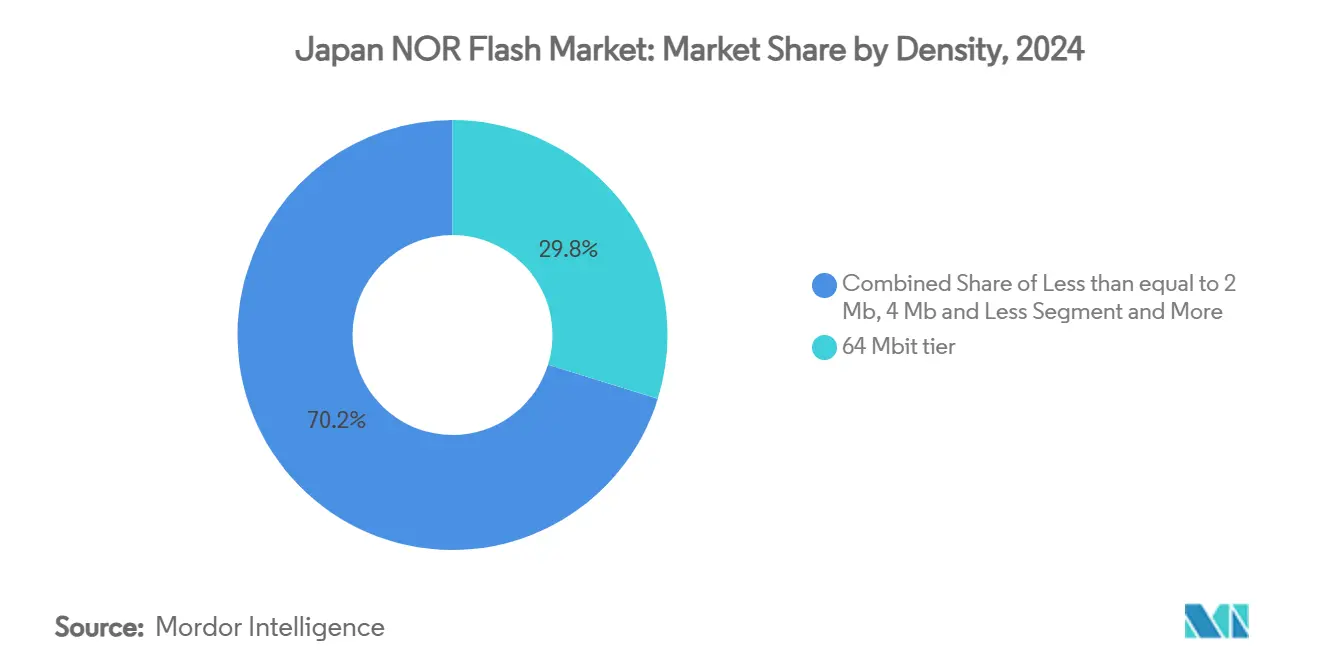
Note: Segment shares of all individual segments available upon report purchase
By Voltage: Energy Efficiency Favors 1.8 V Class
The 3 V class maintained a 51.3% slice in 2024, favored by legacy automotive and programmable-logic platforms. Yet battery-powered IoT, wearables, and consumer gadgets gravitate toward 1.8 V parts that cut active and standby currents. Japan NOR Flash market size for the 1.8 V segment is projected to expand briskly, mirroring demand for always-on sensor nodes in smart-home ecosystems.
Wide-voltage offerings (1.65 V–3.6 V) give design flexibility, minimizing SKU count for manufacturers shipping across multiple end-markets. Ultra-low-voltage NOR remains niche, deployed in energy-harvesting tags or medical implants. Overall, the voltage landscape echoes Japan’s broader carbon-reduction goals by prioritizing low-power silicon adoption.
By End-User Application: Automotive Outpaces Overall Market
Consumer electronics still contributed 36.7% revenue in 2024, reflecting stable demand from smart TVs, cameras, and game consoles. Yet automotive software stacks are swelling: digital cockpits, domain controllers, and EV battery management collectively push automotive NOR consumption toward a 3.7% CAGR. The Japan NOR Flash market thus parallels the nation’s EV penetration targets and ADAS regulation timetables.
Industrial automation benefits from Society 5.0’s emphasis on resilient supply chains and smart manufacturing, sustaining a healthy share. Meanwhile, 5G base-station rollouts anchor communications infrastructure demand, with NOR’s fast-boot traits vital for O-RAN hardware reconfigurations. Medical, aerospace, and defense round out the “other” bucket, each valuing longevity and security assurances intrinsic to NOR-based code storage.
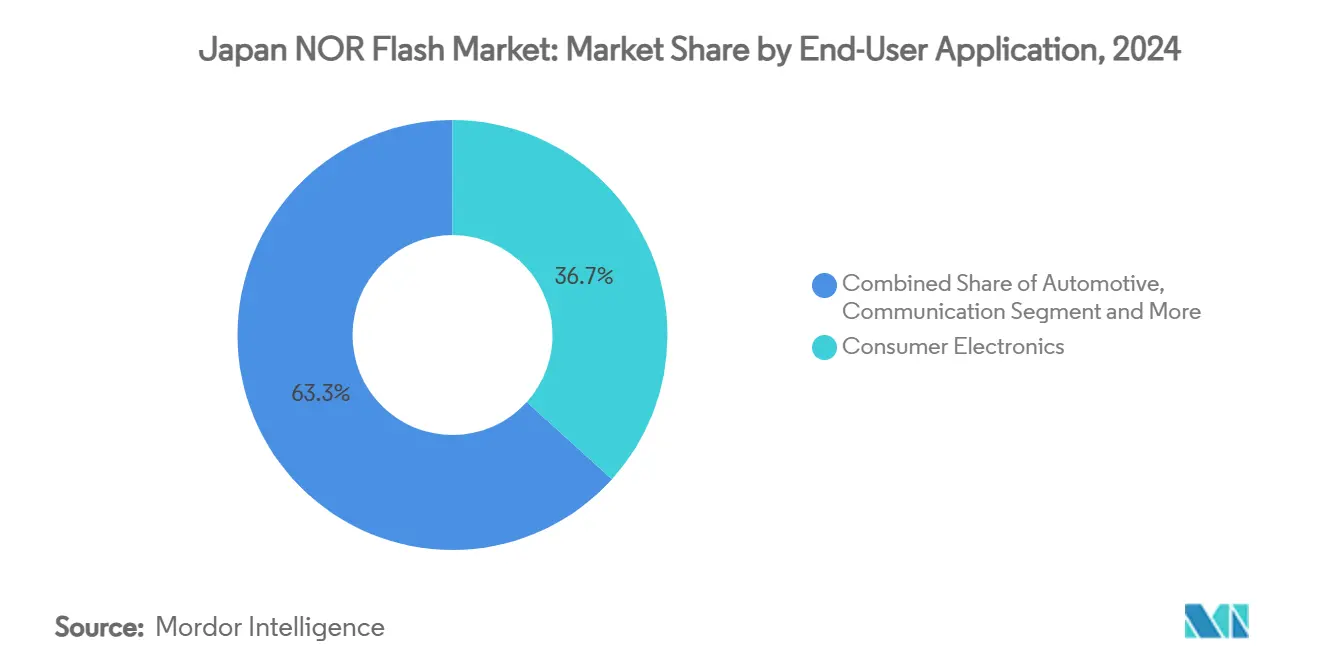
Note: Segment shares of all individual segments available upon report purchase
By Process Technology Node: Advanced Scaling Gains Momentum
Process node 55/58 nm held a 45.3% share in 2024, delivering proven yields and price points. Yet the Japan NOR Flash market is pivoting toward 28 nm and below, accelerating at 3.6% CAGR as cars, robots, and telecom blades require high-bandwidth memory on ever-smaller die areas. NOR scaling does meet Fowler-Nordheim tunneling limits, yet vendors pursue design-centric tricks like charge-trapping layers and per-block ECC to extend roadmaps.
90 nm or older nodes still support cost-sensitive or extremely rugged uses where new-node depreciation is unjustified. Transitional 65 nm and 45 nm volumes stay relevant until sub-28 nm yields stabilize domestically. Government capex subsidies, plus TSMC’s Kumamoto joint venture, aim to bridge the gap, but high-power costs and talent shortages slow down immediate high-volume ramp.
By Packaging Type: WLCSP Captures Mobile and IoT Designs
QFN/SOIC led with 44.3% share in 2024, prized for mechanical robustness and reflow familiarity in automotive electronics. Chip-scale solutions, especially WLCSP, register the swiftest 3.4% CAGR as smartphone OEMs and IoT modules struggle with board real estate. The Japan NOR Flash market aligns with miniaturization roadmaps, favoring wafer-level packages that slash z-height for slim form factors.
BGA/FBGA continues as the workhorse for high-density parallel NOR and industrial boards that value thermal conductivity. Specialty options—hermetic, stacked-die, or custom leadless—serve defense and medical devices with strict environmental standards. Packaging evolution underscores broader system-integration trends, where NOR must coexist with MCU, RF, and PMIC dies in compact footprints.
Geography Analysis
Japan NOR Flash market is concentrated across the Kyushu, Kanto, and Kansai corridors, mirroring semiconductor clustering strategies. Kyushu, bolstered by TSMC’s Kumamoto fab, is rising as a “Silicon Island” that leverages regional university talent and existing back-end facilities. Government-funded infrastructure—roads, power grids, and water treatment—reduces logistics costs and shortens supply chains, attracting tier-one memory suppliers.
The Tokyo-Yokohama belt hosts major consumer-electronics and automotive-electronics design centers, generating steady prototype demand and sustaining high-mix, low-volume NOR lines. Proximity to research institutes fuels joint projects on secure-boot algorithms, density scaling, and low-power design, reinforcing Japan NOR Flash market resilience.
Kansai’s Osaka and Kyoto provinces contribute through factory-automation giants that spearhead Society 5.0 implementation. These industrial clusters purchase NOR-equipped PLCs and AI edge controllers, ensuring stable pull for rugged, extended-temperature parts. Tohoku complements with reconstruction-driven investments, offering lower land costs and risk-diversified manufacturing nodes for future wafer expansions.
Competitive Landscape
The Japan NOR Flash market competition is moderately fragmented. Domestic champions like Renesas Electronics anchor local ecosystems, often co-designing memory with MCU and SoC roadmaps. Global suppliers—Macronix, Winbond, Infineon—pair process technology leadership with Japanese assembly partners to secure automotive-grade quality flows.
Suppliers differentiate on application-specific attributes rather than price. Winbond’s ISO26262-ready TrustME® line targets secure over-the-air updates, while Infineon’s SEMPER™ series focuses on functional-safety and extended-temperature grades. Strategic alliances abound: Renesas collaborates with Winbond to pair R-Car SoCs with high-bandwidth Flash, accelerating time-to-market for next-gen instrument clusters. Vendors also nurture software and board-support-package toolchains that streamline xSPI adoption, further locking in customers.
Security features have become a new battleground. Enhanced on-chip cryptography, monotonic counters, and PUF-based keys help NOR Flash maintain its indispensable status in software-defined vehicles and connected-factory nodes. Consequently, players that integrate security by design and offer longevity guarantees up to 20 years are positioned to secure disproportionate design wins as Japan’s digital infrastructure modernizes.
Japan NOR Flash Industry Leaders
-
Infineon Technologies AG
-
Winbond Electronics Corporation
-
Renesas Electronics Corporation
-
Macronix International Co., Ltd.
-
GigaDevice Semiconductor Inc.
- *Disclaimer: Major Players sorted in no particular order
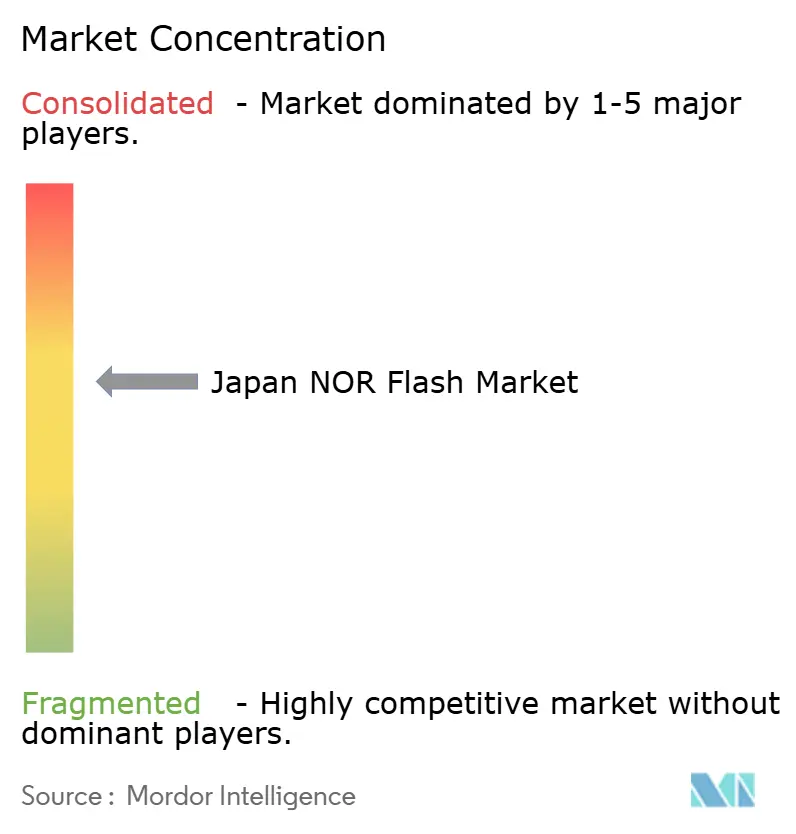
Recent Industry Developments
- May 2025: Infineon Technologies achieved ASIL-D certification for its SEMPER™ NOR Flash family, underlining a safety-first portfolio expansion aimed at autonomous-driving ECUs. The certification strengthens Infineon’s competitive standing with OEMs prioritizing ISO26262 compliance and accelerates design adoption across ADAS platforms.
- May 2025: Renesas Electronics rolled out the RZ/A3M MPU with integrated DDR3L and external NOR/SLC-NAND support via QSPI, targeting cost-efficient HMIs. The launch broadens Renesas’ edge-computing presence and bundles memory flexibility to entice appliance and industrial OEMs struggling with bill-of-materials constraints.
- March 2025: NVIDIA introduced the Aerial CUDA-Accelerated RAN architecture for 5G, demanding high-performance boot memory in radio units. By promoting software-defined base-stations, NVIDIA indirectly builds a larger addressable market for Octal/xSPI NOR that guarantees swift firmware loads.
- December 2024: Winbond unveiled the TrustME® W77T Secure Flash family, spanning 64 MB- 1 GB densities with ISO26262 and ISO21434 credentials, tailored for software-defined vehicles. The secured Flash remedies rising vulnerability concerns and aligns Winbond with Tier-1 ECU makers migrating to zonal architectures.
Research Methodology Framework and Report Scope
Market Definitions and Key Coverage
Our study defines the Japan NOR flash memory market as manufacturer-level revenue from serial and parallel NOR flash integrated circuits that are fabricated or finally sold into devices assembled within Japan. These ICs serve code storage roles where rapid read latency, execute-in-place, and high endurance are critical across consumer gadgets, 5Gradios, automotive ECUs, and factory controllers.
Scope Exclusion: NAND flash, DRAM, phase-change or ReRAM devices, and downstream module or board-level assembling services are outside our numbers.
Segmentation Overview
- By Type (Value, Volume)
- Serial NOR Flash
- Parallel NOR Flash
- By Interface (Value)
- SPI Single / Dual
- Quad SPI
- Octal and xSPI
- By Density (Value)
- 2 Megabit And Less NOR
- 4 Megabit And Less-NOR (greater than 2mb) NOR
- 8 Megabit And Less (greater than 4mb) NOR
- 16 Megabit And Less (greater than 8mb) NOR
- 32 Megabit And Less (greater than 16mb) NOR
- 64 Megabit And Less (greater than 32mb) NOR
- 128 Megabit and Less (greater than 64MB) NOR
- 256 Megabit and Less (greater than 128MB) NOR
- Greater than 256 Megabit
- By Voltage (Value)
- 3 V Class
- 1.8 V Class
- Wide-Voltage (1.65 V – 3.6 V)
- Others - 1.2V Class (and similar sub-1.8V) (2.5V, 5V, etc.)
- By End-user Application (Value, Volume)
- Consumer Electronics
- Communication Infrastructure
- Automotive
- Industrial
- Other Applications
- By Process Technology Node (Value)
- 90 nm and Older
- 65 nm
- 55 nm (incl. 58 nm)
- 45 nm
- 28 nm and Below
- By Packaging Type (Value)
- WLCSP / CSP
- QFN / SOIC
- BGA / FBGA
- Others
Detailed Research Methodology and Data Validation
Primary Research
To validate desk findings, we interviewed fabless chip designers in Yokohama, OSAT managers, Tier-1 ECU firmware architects, and procurement leads at G base-station OEMs across Kanto, Kansai, and Kyushu. Their insights on density migration toward 128-Mbit parts, SPI adoption in 5Gradios, and AEC-Q100 qualification hurdles refined usage ratios and price curves that desk sources could only hint at.
Desk Research
Analysts first compiled publicly available anchors such as METI's electronic parts production index, Japan Customs HS-8542 export files, JEITA shipment tallies, and WSTS unit splits, which help us translate wafer output to packaged die flow. Complementary context came from Bank of Japan price data, patent landscaping drawn through Questel, and financial disclosures in 10-Ks, Yuho filings, and investor decks of leading memory suppliers. Where visibility was limited, D&B Hoovers and Dow Jones Factiva fed us company-level revenue clues. This list is illustrative; numerous additional databases and press archives were tapped to cross-check figures and narratives.
Market-Sizing & Forecasting
Our model begins with a top-down reconstruction that scales domestic MCU, wireless and automotive production volumes by NOR penetration rates, then applies blended ASPs derived from customs and channel checks. Select bottom-up cross-tests, supplier roll-ups and sampled ASP × unit calculations flag gaps before adjustments. Key drivers modeled include: 1) 5Gbase-station roll-out pace, 2) EV and ADAS vehicle build counts, 3) average die density uplift, 4) yen-to-USD shifts affecting local ASPs, and 5) fab capacity additions at 55 nm and below. Forecasts rely on a multivariate regression layered over ARIMA trend extensions, with coefficient ranges validated through expert consensus interviews.
Data Validation & Update Cycle
Outputs undergo anomaly scans against independent metrics, peer review by a senior analyst panel, and finally a pre-publication refresh. Mordor Intelligence revisits each data set annually, triggering interim updates when major capacity ramps, policy moves, or price shocks emerge.
Why Mordor's Japan NOR Flash Baseline Earns Trust
Published values often differ because firms pick dissimilar product mixes, geographic cuts, and pricing paths. Our disciplined, Japan-only scope and annual refresh cadence limit those distortions.
Key gap drivers include others bundling NAND with NOR, reporting global revenues, or layering consultancy services into market value, whereas our figure captures pure NOR silicon shipped within Japan at factory gate pricing.
Benchmark comparison
| Market Size | Anonymized source | Primary gap driver |
|---|---|---|
| USD 275.78 M (2025) | Mordor Intelligence | - |
| USD 3.07 B (2024) | Regional Consultancy A | Combines NAND and NOR for Japan, inflating total addressable market |
| USD 3.22 B (2025) | Global Consultancy B | Reports global NOR revenues, not country-specific view |
| USD 5.27 B (2025) | Industry Journal C | Adds customization services and applies optimistic price escalation |
Taken together, the comparison shows that when variables are tightly aligned to Japan-only silicon sales, Mordor's measured baseline offers decision-makers a balanced, reproducible starting point backed by transparent steps and continuous validation.
Key Questions Answered in the Report
What is the current value of the Japan NOR Flash market?
The market is valued at USD 275.78 million in 2025 and is forecast to reach USD 322.53 million by 2030, marking a 3.2% CAGR.
Which segment is growing fastest within the Japan NOR Flash market?
Automotive applications lead growth at a 3.7% CAGR due to rising ADAS, EV, and digital-cockpit deployments.
Why are Octal and xSPI interfaces gaining traction?
They deliver up to 400 MB/s bandwidth with minimal pin-count increases, meeting boot-time and throughput needs of automotive and 5G equipment.
How is Japan addressing supply-chain resilience for semiconductors?
METI’s early-warning mechanism and JPY 3.9 trillion in subsidies encourage local wafer-fab expansion and mitigate import disruptions.
What competitive strategies dominate the Japan NOR Flash industry?
Firms emphasize application-specific performance, security features (ISO26262, ISO21434), and strategic partnerships with MCU and SoC vendors to embed NOR into end-system reference designs.
Does SLC NAND threaten NOR Flash demand?
Yes, in cost-sensitive consumer electronics, SLC NAND’s 4× cost advantage at higher densities drives substitution, though NOR retains dominance where execute-in-place and safety certifications are critical.
Page last updated on:
